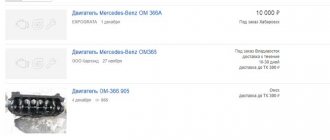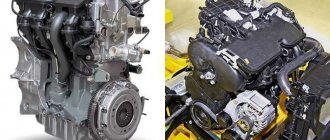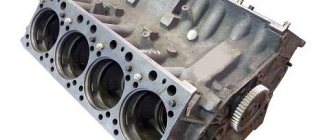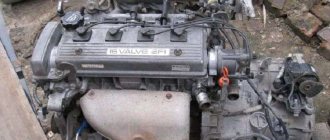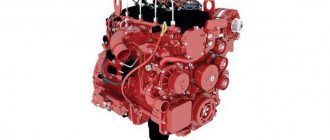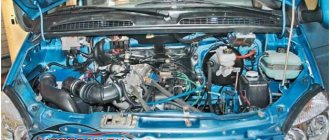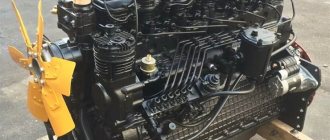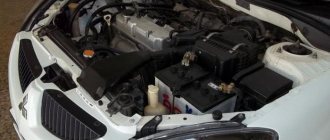Malfunctions, their causes and elimination
Since the first modification has been discontinued, only motor 21128, produced after 2014, is considered. The main “diseases” of the power drive are:
| Shaft does not rotate when starting | 1) damage to the flywheel ring 2) faulty starter 3) failure of the ignition switch 4) starter relay failure | 1) repair or replacement of a part 2) replacement/repair 3) installation of a new lock 4)relay replacement |
| Problems starting the engine | 1) cold 2) warmed up | 1) repair of the control system, checking the tightness of the injectors, coolant temperature sensor, power system 2) replacing the air filter cartridge, tightening the battery terminals, repairing the power system |
| Noises in the starter | 1) loose fastening 2) worn out flywheel teeth | 1) tightening fasteners 2) replacing the crown |
| Engine overheating | 1)fan failure 2)thermostat failure 3) radiator clogged 4) low coolant level | 1) unit repair 2) part replacement 3)flushing channels 4) adding antifreeze to the level |
After modification, the 21128 engine consumes less oil, but its level should be constantly monitored.
Overhaul of the block
Disadvantages and reviews of ICE 21128
Experienced mechanics recommend changing the oil more often with this engine than with others. For example, every 5 thousand kilometers there must be a mandatory procedure for changing the lubricant. Otherwise, scuffs will form on the valves and cylinder walls from low-quality and used oil with various impurities.
It is recommended to buy oil only in specialized stores and from well-known companies. The parameters of the lubricant should not deviate from 5W30, 5W40. To change the fluid you will need 3.5 liters of lubricant.
The car owner of engine 21128 will be plagued by frequent malfunctions of the oil pump, timing belt, thermostat and other minor problems. This cannot be avoided, since the engine is still not fully developed.
Coolant leakage is a frequent guest of this engine 21128. Therefore, it is necessary to measure the antifreeze level after 30 thousand kilometers and carefully monitor overheating. Motor 21128 does not like high temperatures. If other power units can withstand a temperature rise of up to 110 degrees Celsius, then 21128 will quickly fail at a constant elevated temperature.
The first thing that occurs is that oil seals and other rubber parts crack and dry out. Then cracks form on the cylinder head and the cylinders themselves.
Similar article Technical characteristics of the ZMZ 402 engine
Troubleshooting is another drawback of the 21128 engine. It occurs due to the filling of low-quality fuel. Bad fuel contaminates the spark plugs and ignition coils. They fail faster. Fuel injectors also become clogged with dirt. As a result, engine 21128 begins to operate unstably.
If the sensors on the 21128 engine break, then the engine speed fluctuates. The most problems are with the following sensors:
- DMRV;
- RXX;
- DPKV.
The throttle sensor often suffers.
The rapid demise of hydraulic compensators occurs due to low-quality oil, which is poured from the manufacturer. And when changing the lubricant, the lifespan of the hydraulic compensators increases, but the cost of refilling with oil increases proportionally. Because good lubrication requires money, and the 21128 engine has a very strong burn. Especially if the engine has worked more than 250,000 kilometers.
Another malfunction that plagues car owners of cars with engine 21128 is the rotation shaft stopping during startup. This happens due to a broken flywheel ring or a faulty starter. There are other reasons - the starter relay breaks, or the ignition switch becomes unusable.
It is treated by replacing the listed parts or repairing them.
The engine starter may make noise when operating. This means that its fastening has become weak or the flywheel teeth have worn out. In this case, only replacing the flywheel or tightening the fastening will help. These works are performed by experienced mechanics in the service center. Although, if the car owner has experience working with the 21128 engine or has ever repaired similar ones, then he can carry out repairs in a garage.
History of origin
Motor 21179 was already in the minds of the engineer much earlier than you can imagine. Even at the end of the USSR, developers began to think about the Lada C project and its power units. Even then, engineers “knew” this motor by its features and power characteristics. But the difficult economic situation of that time and the collapse of the USSR forced the engineers to completely forget the Lada-Ts project.
And now, after a long time, when Boo Anderson comes to the post of general manager of AvtoVAZ, the project is raised and developed again.
The main task was to create an engine with good low-end torque, which AvtoVAZ lacked for a confident, comfortable ride. “Tractor” 8-cl engines have long since become obsolete, but the new 16-cl engines had a more “sporty” character. The situation was corrected by the then 21127 engine, now 21129, which is installed on Vesta, Xray, and other AvtoVAZ models. Due to the intake receiver with variable geometry installed on it, the torque from the bottom began much earlier, unlike the Prioromotor (21126), and its shelf was much further, right up to the cutoff. But with the start of production of a sedan with a larger mass - the Vesta, and the Xray hatchback - the need for low-end engines reappeared.
The engine was run in and tested for a long time. As a result, during the testing process it turned out that the rings were already stuck at 4t.km., as a result, the heat zone was increased and the problem disappeared.
Nissan HR16DE engine with 110 hp power. It copes well with its task on front-wheel drive. But if you have all-wheel drive, it will strain, get hot, eat a lot and not drive.
Another factor in the creation of the 21179 motor is economics and politics. Because the Nissan engine, although it is assembled here, still belongs to Nissan. And in the event of an unfavorable economic situation, an increase in exchange rates, the cost of its production and sale may simply be unprofitable.
Start of production of motor 21179
Back in 2014, there were rumors about the possible production of a 1.8 liter engine with phase shifters. And yet it became a reality. Previously, OPP and its subsidiary Super-Auto were already engaged in the construction and installation of a 1.8 liter engine with index 21128, which was installed in Priora Sport. But that engine did not have a special resource.
Advantages and disadvantages
The advantages of the 21129 engine are:
- economical consumption of coolant, engine oil and fuel;
- compliance with Euro-5 standards;
- improved attachments;
- overhaul on your own;
- declared resource 200,000 km;
- absence of periodic adjustments of valve thermal clearances.
To ensure the specified motor life, the manual recommends using only high-quality lubricants from reliable manufacturers. The disadvantages of the power drive design are:
- expensive maintenance due to the need for high-quality oil in hydraulic pushers;
- high capital repair budget due to the use of ShPG and timing belt kits from foreign companies;
- there is a danger of bending the valves if the timing belt drive breaks.
The compression ratio has decreased by 0.5 units, which seems to reduce the octane number of the fuel. In practice, the quality of domestic gasoline is unsatisfactory; experts do not recommend experimenting for dubious savings in the operating budget.
Characteristics of engine 21128
The priority task of the Super-Auto manufacturer was to increase the power of the 21124 internal combustion engine, which does not bend valves, which was taken as a basis, so changes took place in the engine:
- the engine diagram remains the same - DONS timing diagram with 2 overhead camshafts;
- a volume of up to 1.8 liters was added - the combustion chambers were enlarged, the cylinders had a size of 82.5 mm, the piston stroke was added to 84 mm;
- the safety of the valves is ensured - deep holes protect them from bending when they meet the pistons at the moment the timing belt drive breaks;
- compression ratio 10.5 units;
- Controller firmware January 5.1, throttle pipe cross-section 51 mm.
Forced motor 21128
As a result, the manual contained a description of the engine parameters - power in the region of 95 - 105 hp. With. and torque at 3200 rpm is about 160 - 162 Nm. The pistons were designed jointly by engineers from AVITI and Super-Auto, since a similar size did not exist in the AvtoVAZ line in principle. The connecting rods are also created for this internal combustion engine, length 129 mm, fastening with a 19 mm pin, fit on a non-standard crankpin 41.5 mm.
With a declared service life of 150,000 km, the manufacturer’s engine could not withstand 100,000 km and consumed a lot of oil - up to 1 liter per 1000 km. The environmental standard has dropped to Euro 2. A “long” piston stroke leads to increased loads on the side surfaces of the cylinders and intense wear of the rings/pistons. This results in high engine oil consumption and the system overheats.
https://youtube.com/watch?v=MkhhtUVGEBQ
https://youtube.com/watch?v=MkhhtUVGEBQ
A year later, Super-Auto management removed the ICE marking 21128-26 from production, replacing it with the following version designated 21128-27:
- the engine does not bend the valve, so a conventional timing belt with a service life of 50 - 90 thousand km is installed;
- cylinders returned to 82 mm size, lightweight pistons from Federal Mogul;
- Mecaprom connecting rods were used;
- a new version of controller firmware has been created;
- valve lift increased to 8.3 mm (0.7 mm more than the original);
- The eco standard has increased to Euro-4.
Modified version of the motor
Since two versions of the 21128 motor were developed, the technical characteristics have changed over time:
| Manufacturer | JSC Super-Auto |
| Engine brand | 21128 |
| Years of production | 2013 (2014) – … |
| Volume | 1597 cm3 (1.6 l) |
| Power | 78 kW (106 hp)/90.5 kW (123 hp) |
| Torque | 148 Nm (at 5800 rpm)/165 Nm (at 4000 rpm) |
| Weight | 116 kg |
| Compression ratio | 10,5 |
| Nutrition | injector |
| Motor type | in-line |
| Injection | distributed electronically controlled |
| Ignition | coil for each spark plug |
| Number of cylinders | 4 |
| Location of the first cylinder | TVE |
| Number of valves on each cylinder | 4 |
| Cylinder head material | aluminum alloy |
| Intake manifold | combined with receiver, polymer |
| An exhaust manifold | catalyst |
| Camshaft | 2 pcs., DONS circuit |
| Cylinder block material | cast iron |
| Cylinder diameter | 82.5 mm, then 82 mm |
| Pistons | lightweight, manufacturer Federal Mogul |
| Crankshaft | original |
| Piston stroke | 84 mm |
| Fuel | AI-95 |
| Environmental standards | Euro-2/4 |
| Fuel consumption | highway – 5.9 l/100 km combined cycle 7.5 l/100 km city – 9.8 l/100 km |
| Oil consumption | 0.7 – 1 l/1000 km, then 0.3 l/1000 km |
| What kind of oil to pour into the engine by viscosity | 5W-30 and 10W-40 |
| Which engine oil is best by manufacturer | Liqui Moly, LukOil, Mannol, Mobil |
| Oil for 21128 according to composition | synthetics, semi-synthetics |
| Engine oil volume | 3.5 l |
| Operating temperature | 95° |
| Motor life | declared 150,000 km actual 100,000 km |
| Adjustment of valves | hydraulic compensators |
| Cooling system | forced, antifreeze |
| Coolant quantity | 7.8 l |
| water pump | with metal impeller |
| Candles for 21128 | BCPR6ES from NGK or domestic AU17DVRM |
| Gap between spark plug electrodes | 1.1 mm |
| Timing belt | Gates, width 22 mm, service life 200,000 km |
| Cylinder operating order | 1-3-4-2 |
| Air filter | Nitto, Knecht, Fram, WIX, Hengst |
| Oil filter | catalog number 90915-10001 replacement 90915-10003, with check valve |
| Flywheel | increased damper size |
| Flywheel mounting bolts | M10x1.25 mm, length 26 mm, groove 11 mm |
| Valve stem seals | code 90913-02090 inlet light code 90913-02088 exhaust dark |
| Compression | from 14 bar, difference in adjacent cylinders maximum 1 bar |
| XX speed | 800 – 850 min-1 |
| Tightening force of threaded connections | spark plug – 31 – 39 Nm flywheel – 62 – 87 Nm clutch bolt – 19 – 30 Nm bearing cap – 68 – 84 Nm (main) and 43 – 53 (rod) cylinder head – three stages 20 Nm, 69 – 85 Nm + 90° + 90° |
Even after modification of the power drive, major repairs are possible after 150,000 km. This is due to the remaining “long” piston stroke, increased loads on the cylinder walls, and intensive production of ShPG parts.
Engine Specifications 21128
The cylinders of the 21114 engine were bored out and taken as the basis for the new 1.8 liter VAZ 21128 engine. The crankshaft was also changed. Instead of the one that was on the VAZ 21124, a crankshaft with a piston stroke of 84 mm was installed.
More detailed technical characteristics of the internal combustion engine 21128 are given in the table.
| Parameter | Meaning |
| Volume in liters | 1,8 |
| Type | Row |
| Torque | 148 Nm |
| Power | 106 horses |
| Cylinders | 4 |
| valves | 16 |
| Cylinder diameter | 82.5 mm |
| Piston stroke | 84 mm |
| Compression ratio | 10,5 |
| Ecoclass | EURO 2 |
| Fuel | Gasoline AI 92 |
| Life resource | 400 thousand kilometers |
Attention! Compared to its predecessor, the power of this engine has increased by 17 horses.
In 2014, another modification of the VAZ21128 engine with a volume of 1.8 liters appeared. It was copied and improved from the VAZ 21126 model. The following table contains its technical characteristics.
| Parameter | Meaning |
| Volume in liters | 1,8 |
| Type | Row |
| Torque | 165 Nm |
| Power | 123 horses |
| Cylinders | 4 |
| valves | 16 |
| Cylinder diameter | 82.5 mm |
| Piston stroke | 84 mm |
| Compression ratio | 10,5 |
| Ecoclass | EURO 4 |
| Fuel | Gasoline AI 92 |
| Nutrition | Injector |
| Life resource | 400 thousand kilometers |
Oil consumption per 1000 kilometers does not exceed 300 grams. Experienced mechanics recommend visiting a service center to change oil and antifreeze components every year.
Reliable, modern engine: VAZ – 21129
It’s our custom to water AvtoVAZ with everything we can, and you know, this is right, especially after money began to be transferred to offshore companies, and 75% of the company was sold to the French owners of the diamond. For example, the Korean brands beloved by many are entirely state-owned enterprises and the money goes into the state treasury.
Engine VAZ-21129
has a volume of 1.6, a power of 106 forces and a torque of 148 Nm. Nothing too outstanding, normal characteristics for 1.6. It’s really difficult to call it technological; it has hydraulic compensators. An intake receiver with variable geometry, which can be said to consist of two receivers with different channel lengths, which are switched by a damper.
The long channel is open up to 4000 rpm, and the short one after 4000. By playing with the filling in this way, it turns out to shift the torque to low revs and keep the torque level at high speeds. In fact, that’s all, there are no superchargers, no high compression ratio, no phase shifter, there is nothing that everyone is used to calling “technology”.
The best part is that Federal Mogul finally learned how to make grooves in the pistons (of course, they knew how to do this before, they just finally started delivering them to the assembly line) and since 2021, most of the new crystal VAZs are produced with a “plug-inless” VAZ-21129 engine.
The VAZ-21129 engine really has one problem
- this is our “maybe it will do”, somewhere the ventilation valve did not open and squeezed out the seals, somewhere the pipes cracked over the year, we never learned how to mill blocks, and so on. And despite this, with a normal oil and spark plug change and banal condition monitoring, this engine runs 300 km or more.
My father, in 2006 he bought himself a new 2115, thought he would drive it for two years and sell it, 13 years have passed, the mileage is 345 thousand, and he doesn’t even think about selling, although he has an L200, but the 15 is economical, cheap, it doesn’t exist It’s a pity, and it doesn’t break, but they just looked after it and didn’t change parts in batches.
VAZ-21129 is a cast iron block
, which is really designed for repairs, all these re-sleevings of aluminum blocks are just an attempt to ride for a while longer. It’s also worth talking about the price, the whole motor (new!) with an attachment costs 120 thousand, for the same Korean the capital with a sleeve will cost under 100.
Do you know why most of us criticize the VAZ?
They did not buy these cars new, but stubbornly believed in the numbers on the dashboard. Starting from the 10th and 15th families, these cars know how to age beautifully; it’s not clear from inside the cabin whether the car has done 300 or 100. Miles have worn everything out. So it worked out: a guy buys a VAZ, the mileage on the dashboard is 40 thousand, something constantly has to be changed, but the quality of the spare parts is such that with the constant replacement of little things, this car becomes golden. His findings car G.
I’m not agitating anyone, I’m just offended by what’s happening to the factories where there really were minds who knew how to do things. The fact is that programming wear requires brains, they are not at the factory, so the motors are still reliable!
Thank you all for your attention! If I offended the feelings of foreign car lovers, I sincerely apologize. Press your finger up and also subscribe to the channel, soon there will be an article about the history of the development of the Korean automobile industry! Source
Source
Design Features
Since the 21128 engine was produced in two versions, both designs should be considered. The version with bored cylinders based on 21124 had the following features:
- the boost was extremely unsuccessful, since it only allowed it to withstand the Euro-2 standard;
- but the safety of the valves when meeting the pistons is ensured (deep holes, as in the original);
- crankshaft and ShPG of original design, which increases the cost of production and overhaul by hand;
- the attachments are well located so that they do not interfere with engine maintenance and replacement of consumables;
- From the factory, the engines are filled with lubricants from Rosneft, the quality of which is insufficient for the normal operation of hydraulic compensators, and when using high-quality oil, the operating budget increases sharply due to high consumption.
Boosting ICE 21128
The second modernization based on version 21126 is more successful:
- The volumes of the combustion chambers are preserved, not only due to the hardware, but also the software part of the ECU;
- pistons are of standard diameter, but the ShPG is foreign-made, the crankshaft is of a special design, repairs are expensive;
- the attachments are more reliable; the original intake air tract receiver is used.
Characteristics of two versions of motors 21128
Does it make sense to buy a Priora in a top-end version?
Some car manufacturers today openly declare that the service life of their products does not exceed 100,000 km. And by modern standards, perhaps even this value can be considered acceptable. It is possible to produce very durable internal combustion engines, but cars equipped with them will not now find sufficient demand among buyers. AvtoVAZ, in a certain sense, continues to behave honestly. It became possible to purchase ShPG parts manufactured using modern technology, and only then the updated 21128 engine was brought to the market. Perhaps similar projects existed before, but mass production was out of the question then (“VAZ would not have cheated” consumers). Make a choice.
Design features of the VAZ-21128 power unit
The new 28th engine has a displacement of 1.8 liters, is built on the basis of the 16-valve engine 21126 and is produced in small batches. A larger volume than is typical for the basic design was obtained only through the use of a ShPG with an increased stroke length. The pistons for this ShPG are manufactured by the Federal-Mogul concern, and sets of crankshafts and connecting rods are purchased in Italy. Let's move on to consider the dynamic characteristics.
Unfortunately, we cannot provide a graph of torque and power. But information related to the VAZ-21128 engine is freely available:
- Maximum power value – 123 hp. (for motor 21126 the parameter is 98 hp);
- The highest torque is 165 N*m (for the “regular Priora” it is 145 N*m);
- A torque of 145 N*m is achieved at low speeds not exceeding 2500 rpm;
- The range of 3500-4000 rpm is characterized by a torque value close to the maximum (165-166 N*m);
- The warranty period is 3 years or 100,000 km.
This is interesting: Starting a car in the cold in winter
This is the engine that AvtoVAZ, or more precisely, its subsidiary Super-Avto, prepared for us. Note that the VAZ-21128 power unit complies with Euro-4 standards (the car plant did not present any surprises here). It is recommended to refuel cars equipped with modern 2112X engines only with AI-95 gasoline. However, owners often compromise, using 92nd gasoline for very specific reasons. We discussed earlier what this could lead to.
Advantages of a sixteen-valve engine
We have already said that the internal combustion engines of the VAZ-2110 (2112) family discussed in the article are distinguished by greater power, lower fuel consumption, and also high technical characteristics, unlike the V8s. It's time to find out what design features make the VAZ 2112 16 valve engine such an attractive choice for motorists.
- fuel economy;
- higher power;
- detonation resistance;
- advanced cooling system;
- simple tuning due to the separation of the intake and exhaust tracts.
It is the separation between the intake and exhaust tracts in the design of the VAZ-21120 and 21124 engines that makes it possible to achieve quite noticeable fuel savings. Thus, the supply of fuel and the intake of exhaust gases is carried out by a separate spaced valve system, due to which there is no unwanted mixing of fuel and combustion products. It is also obvious that this increases the efficiency of the engine and its power.
Sixteen-valve VAZ 2110 engine
The innovations did not ignore the combustion chamber, as well as the structure of the cylinder block. Their design is slightly modified in such a way that the risk of detonation of the fuel mixture is minimized. This is truly a significant advantage, because the quality of gasoline in our gas stations leaves much to be desired. Accordingly, this kind of internal combustion engine design remains a guarantee of its long service life.
The operation of the cooling system of such devices is also pleasing with high stability. This is the most important factor ensuring long engine operation and reliability during its operation. Effective heat removal allows the internal combustion engine to operate at a given temperature, preventing premature wear. Are the benefits of 16 valves significant enough for you? But that is not all.
1.8 liter engine with your own hands.
The production of the Lada Vesta is expected to begin in 2021. One of the possible engines for this car is VAZ 21176. This is a new engine with a displacement of 1.8 liters. Its torque at 3000 rpm will be 173 Nm and maximum power 122 hp. It’s worth remembering which 1.8-liter engine was produced earlier.
The VAZ 21128 engine was developed and put into production by Superauto JSC in 2003. It is still in production today. Torque at 3200 rpm 162 Nm, maximum power 105 hp. (75 kW). The engine was developed on the basis of the VAZ 21124 engine and externally had the same dimensions. An original piston, connecting rod and crankshaft were developed for the engine. The crankshaft connecting rod journals have a diameter of 41.5 mm. The cylinders are bored to 82.5 mm. It’s hard to say why they didn’t leave the standard size at 82 mm. This is probably foolproof. The piston stroke is 84 mm, which required the use of a shortened connecting rod 129 mm long.
The result was an engine with high torque but low service life. Let's compare. The newest VAZ 21127 engine currently in production, with a displacement of 1600 cc, produces a torque of 148 Nm at 4000 rpm and a power of 106 hp. at 5800 rpm. At the same time, it has a piston diameter of 82 mm and a stroke of 75.6 mm. Engine life is 200 thousand km. Oil consumption is minimal.
The reason for the low resource is the ratio of the piston stroke and the length of the connecting rod. Large swing angles and, accordingly, large lateral loads on the piston and cylinder surface. Engine 21128 does not always withstand 100 thousand mileage. Oil consumption from 300 g per 1000 km. This engine is quite exotic and you can’t buy a car with it everywhere. Leon Motors reviews of the car dealership will help you navigate
Want to build your own engine?
You can go the proven route - buy a set of parts for the 128th engine. Bore the cylinder block, replace the crankshaft, pistons and connecting rods.
You will need a cylinder block. What kind of engine do you want to build? Probably 16 valve. This means you need a cylinder block for a VAZ-21124 or VAZ-21126 engine. In the latter, the cylinder mirror is processed more efficiently, but if you plan to bore the engine cylinders, then this does not matter. Moreover, it is better to take a used cylinder block. The cylinder block of the VAZ 21124 engine is designated as 11193-1002011, for the VAZ 21126 the designation will be 21126-1002011. Both of these blocks have a height from the center of the crankshaft of 197.1.
Other engine configuration options are possible. When selecting spare parts for your engine, you should keep the following in mind - at top dead center the piston should not reach the cylinder head. It is better if it does not reach the top plane of the block.
For example, for a VAZ-21126 engine, the crankshaft radius is 37.8 mm, the compression height of the piston (height from the piston pin axis to the upper plane of the piston) is 25.4 mm, the length of the connecting rod is 133.32 mm. 197.1 - 37.8-133.32- 25.4 = 0.58mm
It is necessary to take into account the diameters of the crankpin journals and the dimensions of the piston pins. You can buy a set of tuning parts to assemble the engine. It's easier and cheaper than assembling the kit yourself. The maximum working volume that can be obtained is 1861 cubic cm. When the cylinder block is bored to 84 mm and the piston stroke is 84 mm. This corresponds to kit 219.18 from STI. The kit includes a crankshaft, connecting rods 129mm long, pistons (compression height 26.2mm), piston rings, valves, piston pins. The kit is designed for installation in a cylinder block with a height of 197.1 mm. There are also kits for a block height of 194.8 mm.
Increasing engine displacement will require increasing combustion chamber volume (to maintain compression ratio). The channels of the block head need to be bored, although the channels in the 16-valve head are already enlarged. You need special controller firmware. The result is a sporty engine. Larger piston diameter and stroke will give you increased torque. Lightweight titanium connecting rods allow the engine to spin up to 8000 rpm. But the resource of such an engine will be low. This is proven by engine 21128.
It’s worth taking a closer look at Vesta’s future engine. If the height of the cylinder block is increased (just a couple of millimeters), with a connecting rod length of 133 mm and excellent honing quality, this may turn out to be an engine that combines power and resource. And suitable for installation on other VAZ cars.
Description of the motor 21128
To make a new model of the VAZ 21128 internal combustion engine in 2014, engineers did not bore the cylinders. Here they used a new crankshaft. We replaced the connecting rod and piston group with a new one from MecaProm.
The lifting distance for the intake and exhaust shafts has also been increased. Now it was 8.3 millimeters instead of the usual 7.6 mm. Such innovations brought the engine an increase in power by 25 horses.
Similar article VAZ 21126 engine, technical characteristics of the engine
Fuel consumption has also changed. For example, on the Lada Priora, which was created in 2015, the fuel consumption of the VAZ 21128 in the city is 9.8 liters per 100 kilometers. When driving on the highway, gasoline consumption drops to 5.6 liters per 100 kilometers. But in mixed mode it increases to 7.2 liters.
What has changed or remained the same in the VAZ 21128 internal combustion engine:
- the two camshafts, which are located at the top of the gas distribution mechanism, remain the same;
- the size of the combustion chamber has increased because the engine volume has increased to 1.8 liters;
- engineers have increased valve safety. We achieved this by creating deep holes. Now they are reliably protected from the bending process when the timing chain breaks;
- the cross-section of the throttle pipe has increased to 5.1 mm;
- installed new firmware on the controller.
The connecting rods and pins for them were also enlarged. The connecting rod size is 129 mm, and the pin size is 19 mm. The fit is carried out on the original crankpin. The size of the latter is 41.5 mm.
Attention! The market price of similar 21128 engines has increased. Many car owners were unhappy with this. This happened because there was no crankshaft with connecting rod journals and a crank radius for the increased piston stroke. Therefore, engineers had to come up with, sketch and implement this scheme almost from scratch. Moreover, the unit underwent lengthy testing and testing before it was released.
Since the first model overheated greatly and consumed oil, the engineers decided to replace it with engine model 21128/27. Thanks to the improvements described above, now the engine does not bend the valve, the timing belt is enough to drive up to 100 thousand kilometers.
As can be seen from the table, the environmental class of the engine has also increased. All these innovations contributed to the increase in popularity of the 21128 engine. In addition, the latest version differs in reliability and power from the first.
However, if the 21128 is poorly cared for, major repairs become possible even after 150,000 kilometers. The thing is that due to the piston stroke, the load on the cylinder walls has increased. The components of the connecting rod and piston group also quickly fail. If the car owner likes to drive harshly and does not warm up the 21128, then these elements quickly fail.
VAZ 2110 injector 8 valves, characteristics, timing device photo
An injector with 8 valves with a volume of 1.5 liters received the engine index VAZ-2111, a more powerful unit with a volume of 1.6 liters (8-liter) received the index VAZ-21114. Recently, modifications of the 21114 engine have been produced; they are installed on almost all today’s Lada models, albeit under a different index.
Today we will talk about the design of the 8-valve injector of the VAZ-2110 as well as the characteristics of this power unit. In our photo at the beginning of the article you can see how the injection engine of the “ten” looks under the hood of the car.
So, how does the VAZ 2110 8-valve injector work? Firstly, the main difference between the carburetor version of the engine and the injector is the supply of fuel to the combustion chamber. If in a carburetor engine the combustible mixture is sucked into the cylinders under the influence of vacuum created by the pistons, then in an injection unit the fuel is injected under pressure. It is because of this that the entire design of the injector and carburetor “ten” fuel systems is different.
It all starts in the gas tank, where an electric fuel pump is installed, whose task is to create the necessary pressure in the rail. From the ramp, fuel under pressure is injected into the combustion chamber through nozzles. The entire injection process is controlled electronically, which opens and closes (via a return spring) the injector solenoid valves, injecting fuel into the engine. But the electronics in the VAZ 2110 8-valve injector do not work on their own, but are guided by signals from pressure sensors in the fuel system, air sensors and throttle position. There is none of this in the carburetor “ten”.
In this regard, let's talk about the pros and cons of the VAZ 2110 8-valve injector. On the positive side, it can be noted that the operation of the injector is more stable, the engine produces more power and torque, while fuel consumption is less than in the carburetor version. But if a carburetor VAZ 2110 can be repaired with almost bare hands, then the injection version requires diagnostic equipment, without which it can be extremely difficult to identify the problem. After all, if one of the sensors turns out to be faulty, then your injection engine may not start or work intermittently.
Below are detailed characteristics of the VAZ 2110 injector 8 valves with a working volume of 1.5 and 1.6 liters.
Engine VAZ 2111 1.5 l. 8-valve injector
- Working volume – 1499 cm3
- Number of cylinders – 4
- Number of valves – 8
- Cylinder diameter – 82 mm
- Piston stroke – 71 mm
- Power – 76 hp (56 kW) at 5600 rpm
- Torque – 115 Nm at 3800 rpm
- Compression ratio – 9.9
- Power system - distributed injection
- Acceleration to 100 km/h – 14 seconds
- Maximum speed – 167 kilometers per hour
- Average fuel consumption – 7.2 liters
Engine VAZ 21114 1.6 l. 8-valve injector
- Working volume – 1596 cm3
- Number of cylinders – 4
- Number of valves – 8
- Cylinder diameter – 82 mm
- Piston stroke – 75.6 mm
- Power – 81.6 hp (60 kW) at 5600 rpm
- Torque – 115 Nm at 3800 rpm
- Compression ratio – 9.6
- Power system - distributed injection
- Acceleration to 100 km/h – 13.5 seconds
- Maximum speed – 170 kilometers per hour
- Average fuel consumption – 7.6 liters
Timing device VAZ 2110 injector 8 valves
Many people are concerned about the question: Do the valves on the VAZ 2110 injection engine bend? No, it doesn’t bend, the 8-valve injector does not suffer from this defect. But this does not mean that you should not monitor the timing belt. Since loosening and subsequent jumping of the belt by a certain number of teeth will lead to inevitable problems
It is worth paying special attention if engine oil gets on the belt; an oiled belt will not last long. Below is a detailed image of the timing diagram of the 8-valve injection engine “tens”
See the photo below.
When replacing the timing belt on a VAZ-2110, it is necessary to clearly align the marks on the camshaft and crankshaft pulleys; without this, the engine will not operate normally. Another important point is that when the tension roller moves to its original state, the marks shift as the belt tension changes. Therefore, carefully check whether the timing marks are clearly aligned before putting on the cover covering the timing belt.
Engine VAZ 21128-100026080. Characteristics of the VAZ 21128 engine.
The engine is four-stroke, with distributed fuel injection, in-line, with an overhead camshaft. The engine cooling system is liquid, closed type, with forced circulation of liquid. The engine has a combined lubrication system: pressure and splash.
| Number of cylinders: | 4 |
| Cylinder displacement, l: | 1,796 |
| Compression ratio: | 11,5 |
| Rated power at a crankshaft speed of 5000 rpm: | 75 kW.-(105 hp) |
| Cylinder diameter, mm: | 82,5 |
| Piston stroke, mm: | 84 |
| Number of valves: | 16 |
| Minimum crankshaft speed, rpm: | 800-850 |
| Maximum torque at 3000-3200 rpm, N*m: | 160 |
| Cylinder operating order: | 1-3-4-2 |
| Octane number of gasoline: | 95 (unleaded) |
| Fuel supply system: | Electronically controlled distributed injection |
| Spark plug: | AU17DVRM, BCPR6ES(NGK) |
| Weight, kg: | 117 |
Engine Features.
The VAZ 21128 engine can be used for installation on VAZ 2110, VAZ 2111, VAZ 2112 cars and their modifications.

